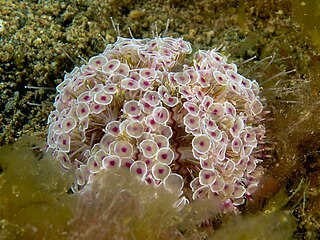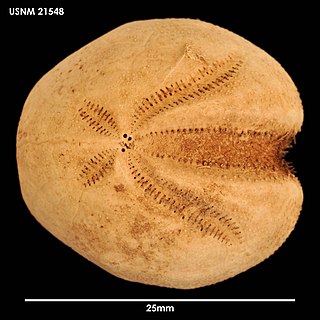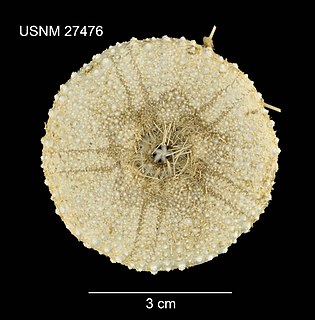
Acanthocidaris hastigera is a species of sea urchin of the family Cidaridae. Their armour is covered with spines. It is in the genus Acanthocidaris and lives in the sea. Acanthocidaris hastingeria was first scientifically described in 1907 by Alexander Emanuel Agassiz & Hubert Lyman Clark.
Anametalia regularis is a species of sea urchin of the family Brissidae. Their armour is covered with spines. It is placed in the genus Anametalia and lives in the sea. Anametalia regularis was first scientifically described in 1925 by Hubert Clark.
Aporocidaris fragilis is a species of sea urchin of the family Ctenocidaridae. It is well-armoured with spines. It is placed in the genus Aporocidaris and lives in the sea. Aporocidaris fragilis was first scientifically described in 1907 by Alexander Emanuel Agassiz & Hubert Lyman Clark.

Aporocidaris milleri is a species of sea urchin of the family Ctenocidaridae. Their armour is covered with spines. It is placed in the genus Aporocidaris and lives in the sea. Aporocidaris milleri was first scientifically described in 1898 by Alexander Emanuel Agassiz.
Araeosoma coriacea is a species of sea urchin of the family Echinothuriidae. Their armour is covered with spines. It is placed in the genus Araeosoma and lives in the sea. Araeosoma coriacea was first scientifically described in 1879 by Alexander Emanuel Agassiz, an American scientist.

Araeosoma coriaceum is a species of sea urchin of the family Echinothuriidae. Their armour is covered with spines. It is placed in the genus Araeosoma and lives in the sea. Araeosoma coriaceum was first scientifically described in 1879 by Alexander Emanuel Agassiz, an American scientist.
Araeosoma eurypatum is a species of sea urchin of the family Echinothuriidae. Their armour is covered with spines. It is placed in the genus Araeosoma and lives in the sea. Araeosoma eurypatum was first scientifically described in 1909 by Alexander Agassiz and Hubert Clark.

Araeosoma leptaleum is a species of sea urchin of the family Echinothuriidae. Their armour is covered with spines. It is placed in the genus Araeosoma and lives in the sea. Araeosoma leptaleum was first scientifically described in 1909 by Alexander Emanuel Agassiz & Hubert Lyman Clark.
Araeosoma tessellatum is a species of sea urchin of the family Echinothuriidae. Their armour is covered with spines. It is placed in the genus Araeosoma and lives in the sea. Araeosoma tessellatum was first scientifically described in 1879 by Alexander Emanuel Agassiz.

Toxopneustes is a genus of sea urchins from the tropical Indo-Pacific. It contains four species. They are known to possess medically significant venom to humans on their pedicellariae. They are sometimes collectively known as flower urchins, after the most widespread and most commonly encountered species in the genus, the flower urchin. Species included in the genus are the following:
Argopatagus planus is a species of sea urchin of the family Macropneustidae. Their armour is covered with spines. It is placed in the genus Argopatagus and lives in the sea. Argopatagus planus was first scientifically described in 1907 by Alexander Emanuel Agassiz and Hubert Lyman Clark, American scientists.
Aspidodiadema tonsum is a species of sea urchin of the family Aspidodiadematidae. Their armour is covered with spines. It is placed in the genus Aspidodiadema and lives in the sea. Aspidodiadema tonsum was first scientifically described in 1879 by Alexander Emanuel Agassiz.

Brisaster moseleyi is a species of sea urchins of the Family Schizasteridae. Their armour is covered with spines. Brisaster moseleyi was first scientifically described in 1881 by Alexander Emanuel Agassiz.
Caenopedina pulchella is a species of sea urchins of the family Pedinidae. Their armour is covered with spines. Caenopedina pulchella was first scientifically described in 1907 by Alexander Emanuel Agassiz and Hubert Lyman Clark.
Centrostephanus asteriscus is a species of sea urchins of the Family Diadematidae. Their armour is covered with spines. Centrostephanus asteriscus was first scientifically described in 1907 by Alexander Emanuel Agassiz & Hubert Lyman Clark.

Chaetodiadema pallidum is a species of sea urchins of the Family Diadematidae. Their armour is covered with spines. Chaetodiadema pallidum was first scientifically described in 1907 by Alexander Emanuel Agassiz and Hubert Lyman Clark.

Cidaris rugosa is a species of sea urchins of the Family Cidaridae. Their armour is covered with spines. Cidaris rugosa was first described in 1907 by Hubert Lyman Clark as Dorocidaris rugosa.

Toxopneustes roseus is a species of sea urchin from the East Pacific. It is sometimes known as the rose flower urchin or the pink flower urchin. Like the related flower urchin, they are venomous.

Toxopneustes maculatus is a rare species of sea urchin found in the Indo-West Pacific.
Aceste is a genus of echinoderms belonging to the family Schizasteridae.











